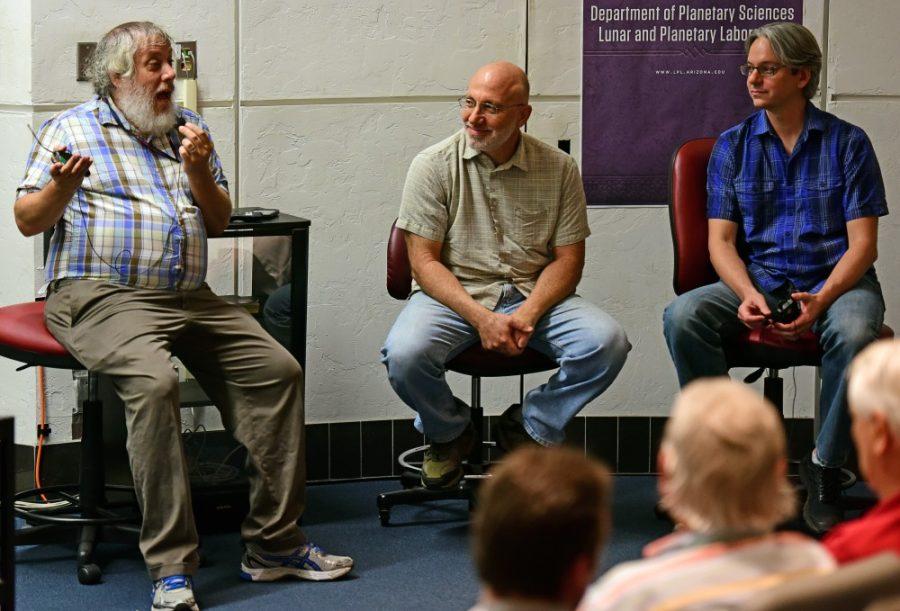The countdown clock that has been hanging in the UA Kuiper Space Sciences building for the past five years will see its end on Sep. 8 when the OSIRIS-REx spacecraft begins its mission to the asteroid Bennu.
OSIRIS-REx is tasked with the mission of retrieving a sample from the surface of Bennu and returning it to Earth’s surface, a mission that will take seven years.
A panel was held with some of the top scientists working on the OSIRIS-REx project during the Lunar and Planetary Laboratory’s Summer Science Saturday this weekend.
“Sept. 8 is the first attempt at the launch, of course this is evening in Florida during hurricane season,” said Tim Swindle, director of the Lunar and Planetary Laboratory and head of the lunar and planetary sciences department. “There’s a month long launch window, so when it launches is kind of up in the air. When it comes back is sort of ironic, we know to the minute when it will come back.”
OSIRIS-REx is the first NASA mission set to capture an asteroid sample and bring it back to earth. Scientists working on the project had to come up with a unique system for collecting their sample from the surface of Bennu, which they often refer to as a touch-and-go maneuver.
Lead Astronomer and Science Operation Planner for the project, Carl Hergenrother, explained the design for collecting the sample.
“[It’s] like an old round air filter for a car,” Hergenrother said. “We touch this air filter to the surface, and blow these inert nitrogen canisters. This kicks up the dirt, which gets caught by the air filter, and like a pogo stick it kind of bounces off the asteroid.”
The OSIRIS-REx spacecraft contains an OCAMS camera suite, which consists of three cameras:
- Polycam, which will be the first to acquire an image of the asteroid
- Mapcam, which searches the area around Bennu for satellites and outgassing plumes
- Samcam, which will continuously document the sample and the touch-and-go maneuver used to collect it
“The OCAM suite will make the job of gathering a sample from the surface of this asteroid a lot safer, and a lot more of a low risk operation,” said Bashar Rizk, senior staff scientist and OSIRIS-REx OCAMS leader.
The reason that Bennu was chosen as the optimal asteroid to visit has to do with its composition, size and proximity to the earth.
Bennu is a rare B-type asteroid, which means it’s primitive, carbon rich and hasn’t significantly changed since formation nearly 4.5 billion years ago.
Scientists expect to find organic compounds and water bearing minerals like clays on Bennu because of its characteristics. The hope is that the samples collected from Bennu may give some insight to the origins of life on Earth.
“We’re ready for launch,” said Michael Nolan, senior research scientist, science chief and physical scientist for the project. “It’s out of our hands, and into the hands of the rocket people. As long as the weather cooperates … we’re in as good of shape as we can imagine.”
During research for the mission, it was determined that Bennu is actually one of the most likely asteroids to collide with earth. Nolan said most likely the odds are somewhere around one in 3,000.
In the off chance that Bennu would collide with Earth, it would not do so for around 175 years, which means that, given the time window, current technology could prevent any sort of collision, according to Nolan and Hergenrother.
UA is hosting an OSIRIS-REx launch event on Sept. 8 from 2:30-5 p.m. The event offers a live stream of the Florida launch, and includes snacks, drinks and activities. To attend, register here by 10 p.m. on Sept. 2.
Ken Thurston, a local Tucson resident and father said he brought his daughters to Saturday’s panel, hoping they would learn something new.
Thurston said “We’ve been really pleased with how engaging the people here are, you can go right up to and talk,” Thurston said. “It’s a fascinating prospect sending something out into space, and bringing samples back in.”
Follow Nicholas Johnson on Twitter.









